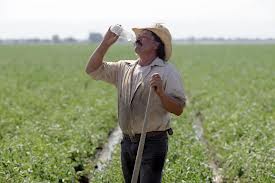As Labor Day approaches, my occupational health roots always come to the fore. And today’s warnings from the National Weather Service about dangerously hot conditions in areas of Minnesota, Wisconsin, Missouri, and Iowa beg reflection on the toll excessive heat takes on workers – and others who live in affected areas. The tragedy is that these serious heat-related health impacts are preventable.
Workers at Risk

Photo by Paul Underhill.
My friend and science writer Elizabeth Grossman puts a human face on the 16 heat-related worker fatalities that occurred over a seven week period this summer. Not surprisingly, three were farm workers. Outdoor workers are particularly at risk of heat-related illness and death; these include construction workers; transportation, sanitation, and utility workers; landscapers and building and grounds maintenance workers; and postal workers among others. Indoor workers can also be exposed to excessive heat, including those who work in foundries, laundries, kitchens, and workplaces with inadequate climate control. Given that over 106 million people were under a heat advisory and over 34 million were under an excessive heat warning on just one day during this period (July 18), the toll could have been higher.

Outdoor workers are disproportionately affected when the weather heats up.
OSHA reports that excessive heat sickened some 4,400 workers in 2011 and killed more than 30 workers a year since 2003. [These deaths occurred in all but a handful of states; see map of heat fatalities, with text describing each one.] To help address these entirely preventable incidents, OSHA launched a heat awareness campaign that provides resources, tips, and tools for outdoor workers, including a smart-phone app that pulls data directly from NOAA to perform heat index calculations and then displays the risk level and protective measures that should be taken to prevent heat illness. OSHA does not have a specific threshold or standard for heat stress; the Department of Labor denied a petition for an emergency temporary standard in 2012. OSHA must rely on its General Duty Clause to enforce worker protection from excessive heat. Several states have adopted heat protection regulations and campaigns for workers, including California, Washington, and Minnesota.
Others are vulnerable
As our Heat in the Heartland report shows, our cities and citizens are feeling the heat; and heat waves top the list of weather-related killers in the United States. Children, the elderly, and people with chronic cardiac and respiratory conditions are especially vulnerable. The Centers for Disease Control and Prevention (CDC) reports that from 1999 to 2010, 7,415 people died of heat-related deaths, an average of about 618 deaths a year. Last summer’s heat wave in Maryland, Ohio, Virginia, and West Virginia resulted in 32 heat-related deaths over a two week period.
More action needed
And as climate change continues to warm our world into the foreseeable future, we will experience more extreme weather events – and can expect more heat-related morbidity and mortality. It’s heartening to see agencies at all levels of government undertake prevention campaigns for workers, develop heat emergency response plans for citizens, and target interventions activities to protect the elderly during heat waves. Recognizing that summer heat also poses risks to young athletes, many states have also adopted new guidelines in response to a spate of heat-related deaths. The realities of a warming world will demand even greater agency attention to public health protection.
What’s missing, of course, is action from our leaders in Washington to reduce emissions that are causing rising temperatures in the first place. They, more than anyone, need to feel the heat.
